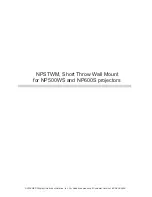
Order No. 2104 ..
made available to KNX display components.
The value of the air humidity measured by the humidity sensor together with the measured room
temperature is used for calculating the dew point.
Dew point alarm
The dew point of water in the formal sense is the condensation point of pure water and thus a
value pair from air humidity and room temperature. The temperature value of the dew point, i.e.
the dew point temperature, is normally equated with the dew point. This concerns the
temperature of the air with a specific humidity at which the condensation on an object is
currently forming.
The dew point temperature is calculated by the device on the basis of the determined room
temperature and is adjusted by means of the Magnus formula. This is an approximation formula
for calculating the saturated vapour pressure depending on the temperature, which is used in
meteorology and building physics.
The dew point temperature determined can be transmitted to the bus as a 2-byte value via a
separate object and be made available to KNX display components, for example. Once the dew
point temperature has been reached, the device can transmit a dew point alarm to the bus in the
form of switching or value telegrams. This dew point alarm can take place up to a maximum
lead of 5 K in order to realise a pre-warning function.
Functionality of binary inputs
The device has a push-button interface with 2 independent channels and transmits telegrams to
the KNX after activation of a connected switch or push-button contact of a rocker or button
depending on the ETS parameter setting. These can be, for instance, telegrams for switching or
push button control, for dimming or for controlling blinds. It is also possible to program value
transmitter functions such as dimming value transmitters or light scene extensions. These inputs
are lockable during operation. The insert for the presence detector is also possible.
Logic gates
In order to implement logical dependencies from external states as well or to cascade, the
device software has four logic gates. Each gate can have from one to a maximum of four inputs.
The type of logic operation can be set as "AND", "OR", "EXCLUSIVE OR" or as "AND with
feedback" for each logic gate. In addition, each input can be operated normally or inverted.
The communication objects of the outputs can be configured as 1-bit or 1-byte objects. Outputs
that transfer switching commands can also work inverted.
The inputs can either be used separately with their own communication objects or can also, if
necessary, be linked optionally to limiting values of the CO
2
- and humidity measurement, to the
objects of the dew point alarm or to output objects of other logic functions. The outputs can work
with a time delay if necessary. The transmission criterion for input event, output change and
cyclical transmission can be set. Several logic gates can be combined with each other for
complex logic operation functions.
General
The device is flush mounted in a switchbox and covers the surface of a socket. The device is a
so-called monoblock product. It does not require any separate bus coupling or additional power
supply.
The programming mode of the device is indicated by a separate programming LED. It is located
on the front of the design covers directly next to the programming button and continues flashing
until an application is loaded. In this manner the device can be commissioned easily with the
ETS even in the installed state. Project design and commissioning of the device is performed
using the ETS 3.0d with Patch A or newer versions.
Page 5 of 171
Product definition






































